MGT602 BDA Business Decision Analytics: Style Analysis Report
VerifiedAdded on 2023/04/08
|9
|1388
|310
Report
AI Summary
This report delves into the author's decision-making tools and preferences, evaluating the decision-making process in light of classmate feedback and personality traits. It examines the application of logic, intuition, and balance in the author's decision-making style, highlighting the influence of a Type A personality on adopting a rational decision-making model. The report reflects on feedback received from classmates, analyzing how decisions are perceived as rushed, emotional, and biased towards peer expectations. It further discusses the sources of data and the utilization of decision-making tools, emphasizing the significance of decisions and their potential consequences. Visual interpretations of data and patterns are included to provide further insights into the decision-making process. The student document is available on Desklib, a platform offering a range of study tools and resources for students.

Running head: MY DECISION-MAKING TOOLS AND PREFERENCES 1
My Decision-Making Tools and Preferences
Name
Student ID
Subject
Class
Word Count
Academic Integrity Statement
My Decision-Making Tools and Preferences
Name
Student ID
Subject
Class
Word Count
Academic Integrity Statement
Paraphrase This Document
Need a fresh take? Get an instant paraphrase of this document with our AI Paraphraser
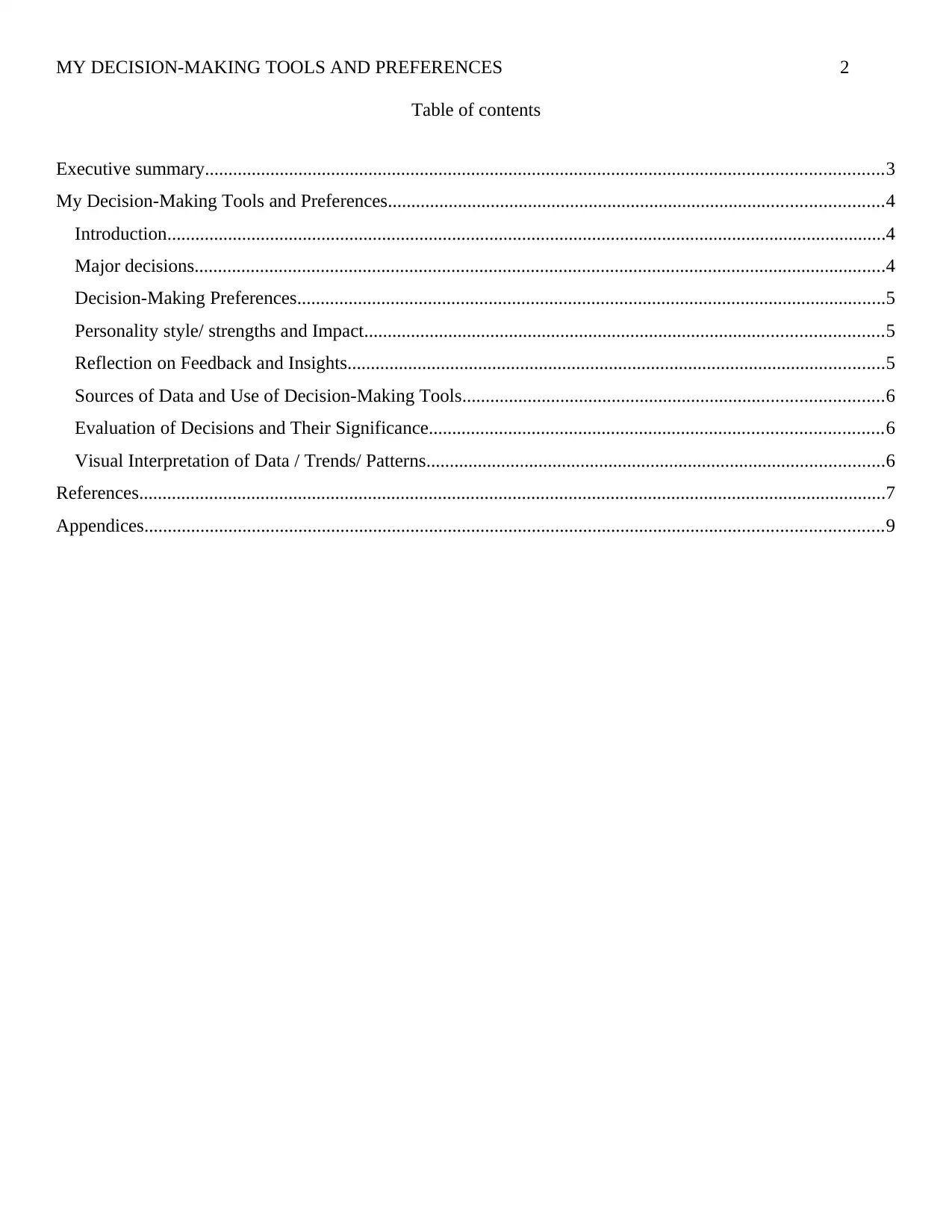
MY DECISION-MAKING TOOLS AND PREFERENCES 2
Table of contents
Executive summary.................................................................................................................................................3
My Decision-Making Tools and Preferences..........................................................................................................4
Introduction..........................................................................................................................................................4
Major decisions....................................................................................................................................................4
Decision-Making Preferences..............................................................................................................................5
Personality style/ strengths and Impact...............................................................................................................5
Reflection on Feedback and Insights...................................................................................................................5
Sources of Data and Use of Decision-Making Tools..........................................................................................6
Evaluation of Decisions and Their Significance.................................................................................................6
Visual Interpretation of Data / Trends/ Patterns..................................................................................................6
References................................................................................................................................................................7
Appendices..............................................................................................................................................................9
Table of contents
Executive summary.................................................................................................................................................3
My Decision-Making Tools and Preferences..........................................................................................................4
Introduction..........................................................................................................................................................4
Major decisions....................................................................................................................................................4
Decision-Making Preferences..............................................................................................................................5
Personality style/ strengths and Impact...............................................................................................................5
Reflection on Feedback and Insights...................................................................................................................5
Sources of Data and Use of Decision-Making Tools..........................................................................................6
Evaluation of Decisions and Their Significance.................................................................................................6
Visual Interpretation of Data / Trends/ Patterns..................................................................................................6
References................................................................................................................................................................7
Appendices..............................................................................................................................................................9
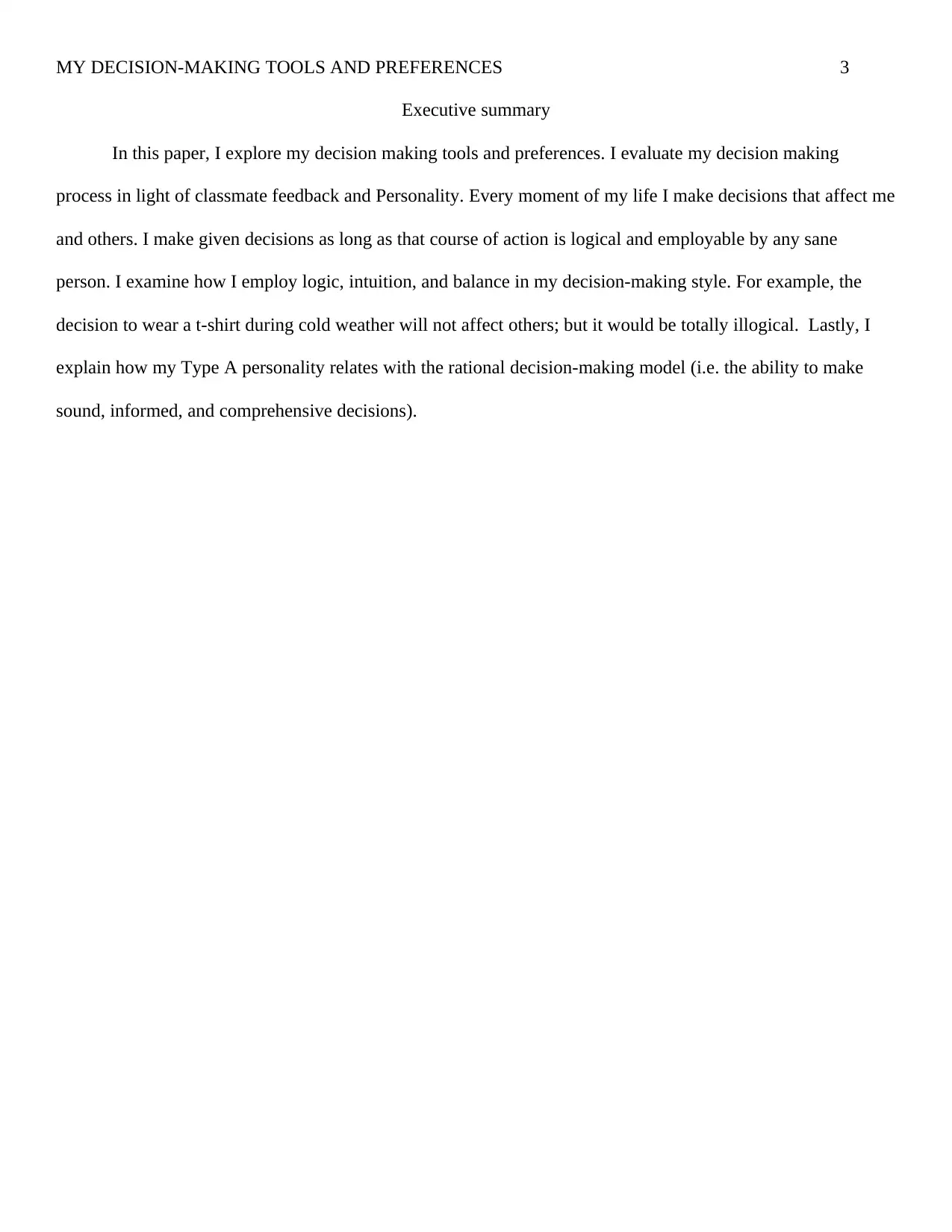
MY DECISION-MAKING TOOLS AND PREFERENCES 3
Executive summary
In this paper, I explore my decision making tools and preferences. I evaluate my decision making
process in light of classmate feedback and Personality. Every moment of my life I make decisions that affect me
and others. I make given decisions as long as that course of action is logical and employable by any sane
person. I examine how I employ logic, intuition, and balance in my decision-making style. For example, the
decision to wear a t-shirt during cold weather will not affect others; but it would be totally illogical. Lastly, I
explain how my Type A personality relates with the rational decision-making model (i.e. the ability to make
sound, informed, and comprehensive decisions).
Executive summary
In this paper, I explore my decision making tools and preferences. I evaluate my decision making
process in light of classmate feedback and Personality. Every moment of my life I make decisions that affect me
and others. I make given decisions as long as that course of action is logical and employable by any sane
person. I examine how I employ logic, intuition, and balance in my decision-making style. For example, the
decision to wear a t-shirt during cold weather will not affect others; but it would be totally illogical. Lastly, I
explain how my Type A personality relates with the rational decision-making model (i.e. the ability to make
sound, informed, and comprehensive decisions).
⊘ This is a preview!⊘
Do you want full access?
Subscribe today to unlock all pages.

Trusted by 1+ million students worldwide
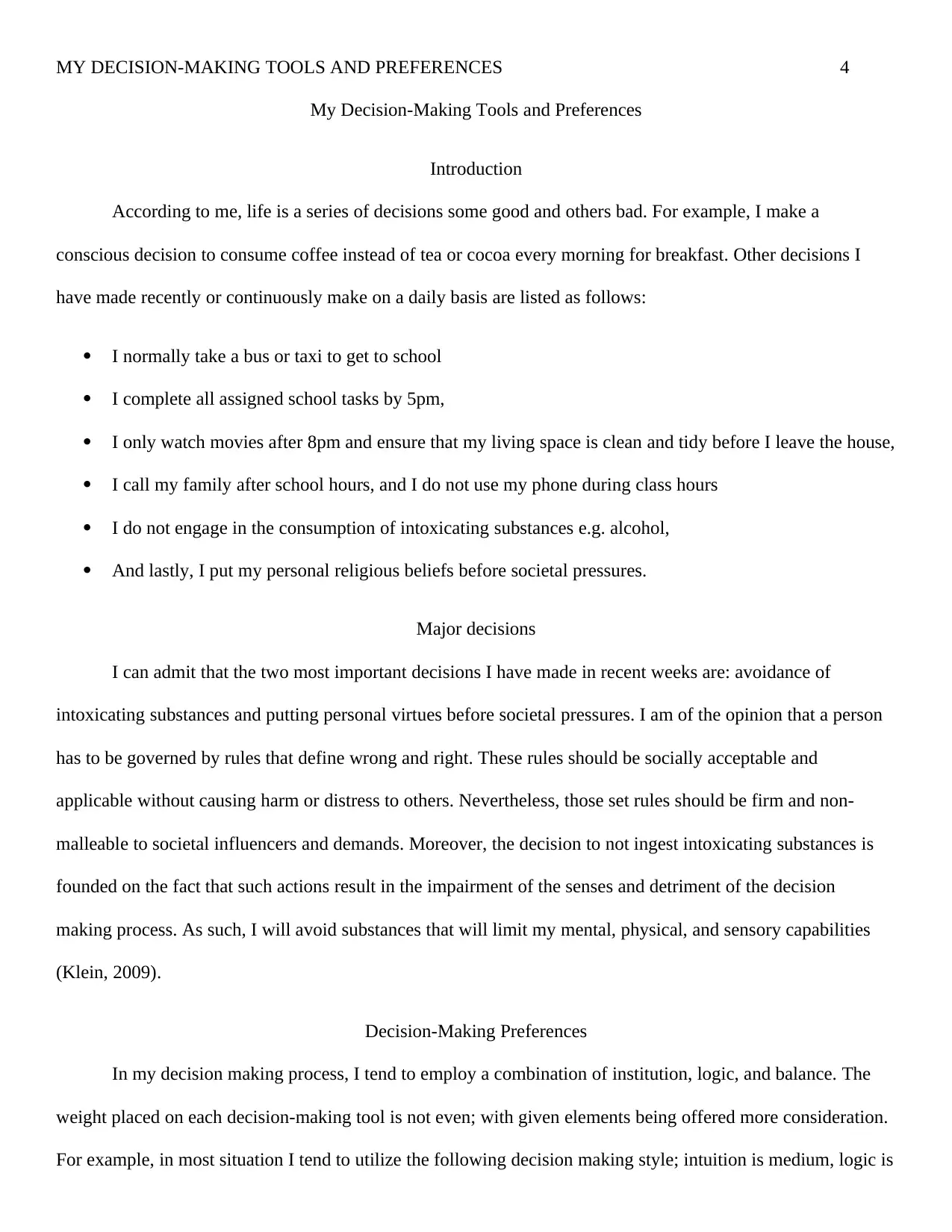
MY DECISION-MAKING TOOLS AND PREFERENCES 4
My Decision-Making Tools and Preferences
Introduction
According to me, life is a series of decisions some good and others bad. For example, I make a
conscious decision to consume coffee instead of tea or cocoa every morning for breakfast. Other decisions I
have made recently or continuously make on a daily basis are listed as follows:
I normally take a bus or taxi to get to school
I complete all assigned school tasks by 5pm,
I only watch movies after 8pm and ensure that my living space is clean and tidy before I leave the house,
I call my family after school hours, and I do not use my phone during class hours
I do not engage in the consumption of intoxicating substances e.g. alcohol,
And lastly, I put my personal religious beliefs before societal pressures.
Major decisions
I can admit that the two most important decisions I have made in recent weeks are: avoidance of
intoxicating substances and putting personal virtues before societal pressures. I am of the opinion that a person
has to be governed by rules that define wrong and right. These rules should be socially acceptable and
applicable without causing harm or distress to others. Nevertheless, those set rules should be firm and non-
malleable to societal influencers and demands. Moreover, the decision to not ingest intoxicating substances is
founded on the fact that such actions result in the impairment of the senses and detriment of the decision
making process. As such, I will avoid substances that will limit my mental, physical, and sensory capabilities
(Klein, 2009).
Decision-Making Preferences
In my decision making process, I tend to employ a combination of institution, logic, and balance. The
weight placed on each decision-making tool is not even; with given elements being offered more consideration.
For example, in most situation I tend to utilize the following decision making style; intuition is medium, logic is
My Decision-Making Tools and Preferences
Introduction
According to me, life is a series of decisions some good and others bad. For example, I make a
conscious decision to consume coffee instead of tea or cocoa every morning for breakfast. Other decisions I
have made recently or continuously make on a daily basis are listed as follows:
I normally take a bus or taxi to get to school
I complete all assigned school tasks by 5pm,
I only watch movies after 8pm and ensure that my living space is clean and tidy before I leave the house,
I call my family after school hours, and I do not use my phone during class hours
I do not engage in the consumption of intoxicating substances e.g. alcohol,
And lastly, I put my personal religious beliefs before societal pressures.
Major decisions
I can admit that the two most important decisions I have made in recent weeks are: avoidance of
intoxicating substances and putting personal virtues before societal pressures. I am of the opinion that a person
has to be governed by rules that define wrong and right. These rules should be socially acceptable and
applicable without causing harm or distress to others. Nevertheless, those set rules should be firm and non-
malleable to societal influencers and demands. Moreover, the decision to not ingest intoxicating substances is
founded on the fact that such actions result in the impairment of the senses and detriment of the decision
making process. As such, I will avoid substances that will limit my mental, physical, and sensory capabilities
(Klein, 2009).
Decision-Making Preferences
In my decision making process, I tend to employ a combination of institution, logic, and balance. The
weight placed on each decision-making tool is not even; with given elements being offered more consideration.
For example, in most situation I tend to utilize the following decision making style; intuition is medium, logic is
Paraphrase This Document
Need a fresh take? Get an instant paraphrase of this document with our AI Paraphraser
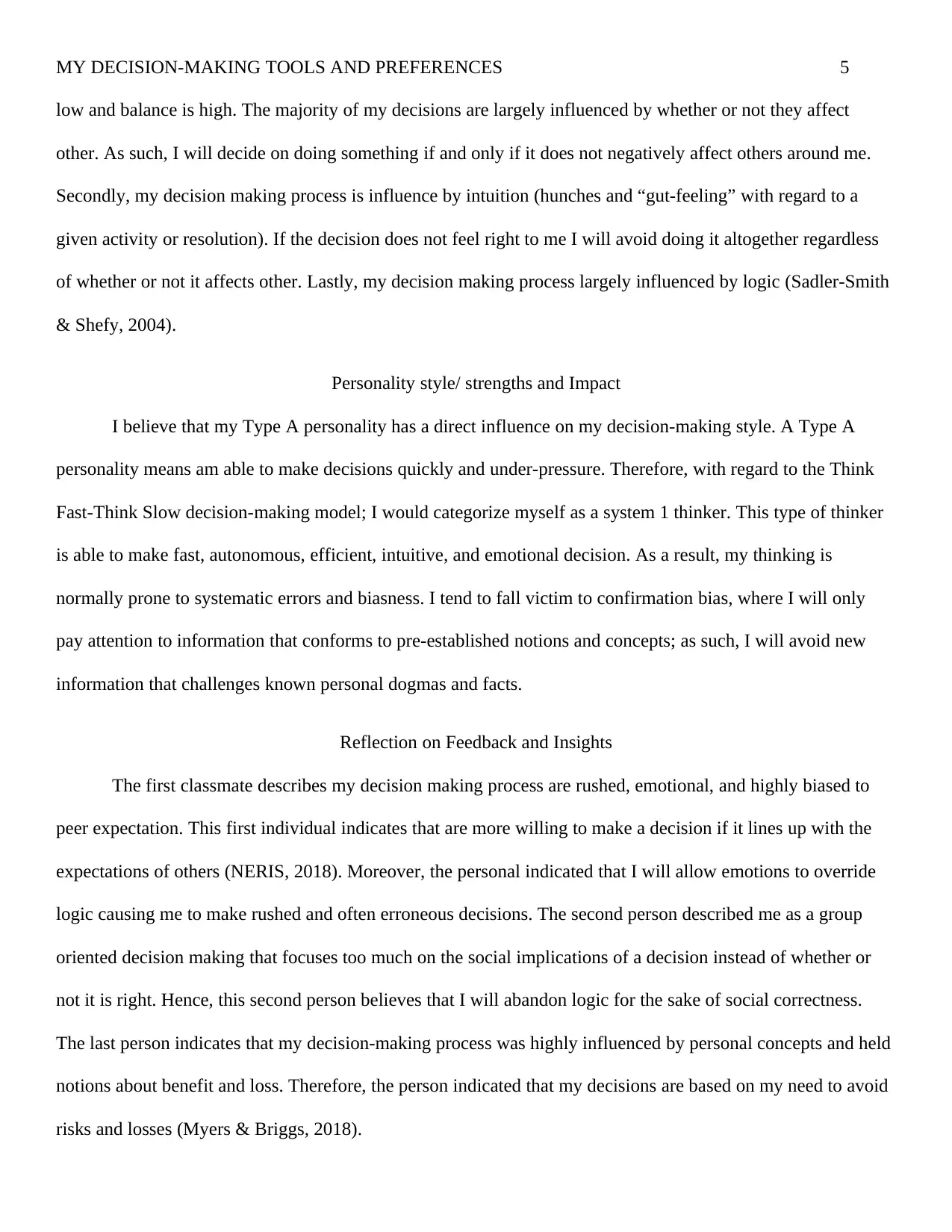
MY DECISION-MAKING TOOLS AND PREFERENCES 5
low and balance is high. The majority of my decisions are largely influenced by whether or not they affect
other. As such, I will decide on doing something if and only if it does not negatively affect others around me.
Secondly, my decision making process is influence by intuition (hunches and “gut-feeling” with regard to a
given activity or resolution). If the decision does not feel right to me I will avoid doing it altogether regardless
of whether or not it affects other. Lastly, my decision making process largely influenced by logic (Sadler-Smith
& Shefy, 2004).
Personality style/ strengths and Impact
I believe that my Type A personality has a direct influence on my decision-making style. A Type A
personality means am able to make decisions quickly and under-pressure. Therefore, with regard to the Think
Fast-Think Slow decision-making model; I would categorize myself as a system 1 thinker. This type of thinker
is able to make fast, autonomous, efficient, intuitive, and emotional decision. As a result, my thinking is
normally prone to systematic errors and biasness. I tend to fall victim to confirmation bias, where I will only
pay attention to information that conforms to pre-established notions and concepts; as such, I will avoid new
information that challenges known personal dogmas and facts.
Reflection on Feedback and Insights
The first classmate describes my decision making process are rushed, emotional, and highly biased to
peer expectation. This first individual indicates that are more willing to make a decision if it lines up with the
expectations of others (NERIS, 2018). Moreover, the personal indicated that I will allow emotions to override
logic causing me to make rushed and often erroneous decisions. The second person described me as a group
oriented decision making that focuses too much on the social implications of a decision instead of whether or
not it is right. Hence, this second person believes that I will abandon logic for the sake of social correctness.
The last person indicates that my decision-making process was highly influenced by personal concepts and held
notions about benefit and loss. Therefore, the person indicated that my decisions are based on my need to avoid
risks and losses (Myers & Briggs, 2018).
low and balance is high. The majority of my decisions are largely influenced by whether or not they affect
other. As such, I will decide on doing something if and only if it does not negatively affect others around me.
Secondly, my decision making process is influence by intuition (hunches and “gut-feeling” with regard to a
given activity or resolution). If the decision does not feel right to me I will avoid doing it altogether regardless
of whether or not it affects other. Lastly, my decision making process largely influenced by logic (Sadler-Smith
& Shefy, 2004).
Personality style/ strengths and Impact
I believe that my Type A personality has a direct influence on my decision-making style. A Type A
personality means am able to make decisions quickly and under-pressure. Therefore, with regard to the Think
Fast-Think Slow decision-making model; I would categorize myself as a system 1 thinker. This type of thinker
is able to make fast, autonomous, efficient, intuitive, and emotional decision. As a result, my thinking is
normally prone to systematic errors and biasness. I tend to fall victim to confirmation bias, where I will only
pay attention to information that conforms to pre-established notions and concepts; as such, I will avoid new
information that challenges known personal dogmas and facts.
Reflection on Feedback and Insights
The first classmate describes my decision making process are rushed, emotional, and highly biased to
peer expectation. This first individual indicates that are more willing to make a decision if it lines up with the
expectations of others (NERIS, 2018). Moreover, the personal indicated that I will allow emotions to override
logic causing me to make rushed and often erroneous decisions. The second person described me as a group
oriented decision making that focuses too much on the social implications of a decision instead of whether or
not it is right. Hence, this second person believes that I will abandon logic for the sake of social correctness.
The last person indicates that my decision-making process was highly influenced by personal concepts and held
notions about benefit and loss. Therefore, the person indicated that my decisions are based on my need to avoid
risks and losses (Myers & Briggs, 2018).

MY DECISION-MAKING TOOLS AND PREFERENCES 6
Sources of Data and Use of Decision-Making Tools
The source of data does affect the decision-making process I decide to follow. For example, when
making a friendly wager with my friend I will employ intuition because the consequences of the decision are
known and quantifiable. On the other hand, when marking a decision on which tertiary learning institution to
join I will employ a mix of logic (high), rationality (High), and intuition (medium). Critical decisions have to be
dealt with in a rational and logical manner as opposed to trivial things like on which side of the bed to step-out
of. Therefore, it is correct to conclude that my decision making process will be affect by the subject matter and
consequences (Akinci & Sadler-Smith, 2012).
Evaluation of Decisions and Their Significance
As indicated above, I am less likely to make a decision based on intuition if the subject matter is
important and has far reaching consequences. Therefore, significance has a crucial pull on the decisions made
and the overall decision-making tools employed (AFM, 2017). The significance of different decision is
therefore malleable depending on my level of prioritization for each of the mentioned decisions. The more life
altering a decision is the more significant it is to me.
Visual Interpretation of Data / Trends/ Patterns
Since I am a very intuitive person, I would much rather visual representations and quantitative data as
opposed to verbal explanations and qualitative data. Therefore, I will gather more insight from visual charts and
tables based on my personality traits. For example the pie chart below tells me that hot conditions were
considerably high compared to cold, rainy, and cloudy condition.
Sources of Data and Use of Decision-Making Tools
The source of data does affect the decision-making process I decide to follow. For example, when
making a friendly wager with my friend I will employ intuition because the consequences of the decision are
known and quantifiable. On the other hand, when marking a decision on which tertiary learning institution to
join I will employ a mix of logic (high), rationality (High), and intuition (medium). Critical decisions have to be
dealt with in a rational and logical manner as opposed to trivial things like on which side of the bed to step-out
of. Therefore, it is correct to conclude that my decision making process will be affect by the subject matter and
consequences (Akinci & Sadler-Smith, 2012).
Evaluation of Decisions and Their Significance
As indicated above, I am less likely to make a decision based on intuition if the subject matter is
important and has far reaching consequences. Therefore, significance has a crucial pull on the decisions made
and the overall decision-making tools employed (AFM, 2017). The significance of different decision is
therefore malleable depending on my level of prioritization for each of the mentioned decisions. The more life
altering a decision is the more significant it is to me.
Visual Interpretation of Data / Trends/ Patterns
Since I am a very intuitive person, I would much rather visual representations and quantitative data as
opposed to verbal explanations and qualitative data. Therefore, I will gather more insight from visual charts and
tables based on my personality traits. For example the pie chart below tells me that hot conditions were
considerably high compared to cold, rainy, and cloudy condition.
⊘ This is a preview!⊘
Do you want full access?
Subscribe today to unlock all pages.

Trusted by 1+ million students worldwide
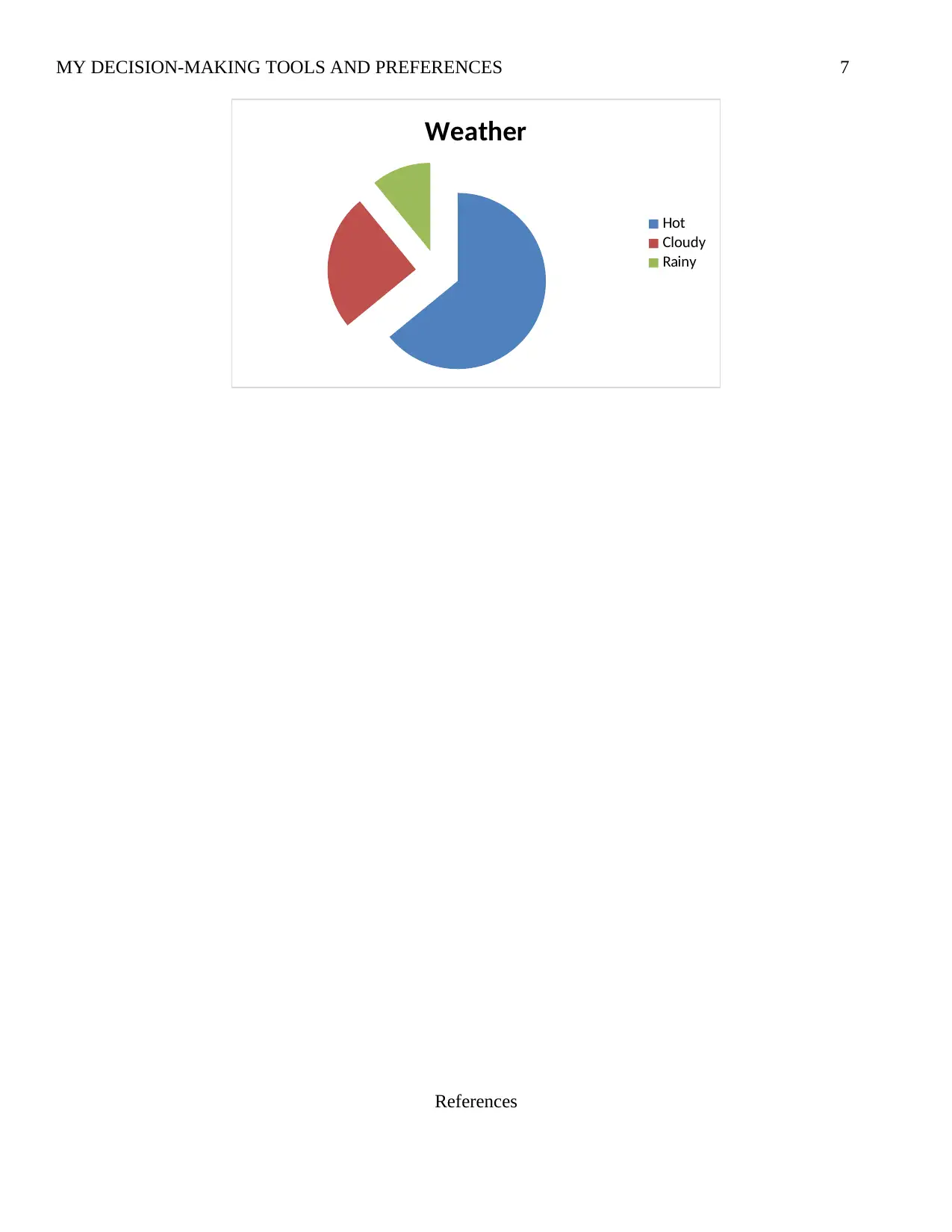
MY DECISION-MAKING TOOLS AND PREFERENCES 7
Weather
Hot
Cloudy
Rainy
References
Weather
Hot
Cloudy
Rainy
References
Paraphrase This Document
Need a fresh take? Get an instant paraphrase of this document with our AI Paraphraser

MY DECISION-MAKING TOOLS AND PREFERENCES 8
AFM, [. A. (2017). Balanced decision-making: Dealing with blind spots. Case study with management boards
of small and medium sized banks. Retrieved March 20, 2019, from AFM [Dutch Authority for the
Financial Markets]: https://www.afm.nl/en/professionals/onderwerpen/gedrag-cultuur-publicaties
Akinci, C., & Sadler-Smith, E. (2012). Intuition in management research: A historical review. International .
Journal of Management Reviews , 14 (1), 104-122.
Dhami, M., & Thomson, M. (2012). On the relevance of cognitive continuum theory and quasirationality for
understanding management judgement and decision making. European Management Journal , 30, 316-
326.
Klein, G. (2009). Ch. 5 Intuition vs analysis . In Streetlights and shadows (pp. 67-82). Boston: MIT Press.
Myers & Briggs, F. (2018). MBTI Basics. Retrieved March 20, 2019, from Myers & Briggs Foundation:
https://myersbriggs.org/my-mbti-personality-type/mbti-basics
NERIS, A. (2018). Our theory. Retrieved March 20, 2019, from 16 Personalities:
www.16personalities.com/articles/our-theory
Sadler-Smith, E., & Shefy, S. (2004). The intuitive executive: Understanding and applying ‘gut feel’ in
decision-making. Academy of Management Executive , 18 (4), 76-91.
AFM, [. A. (2017). Balanced decision-making: Dealing with blind spots. Case study with management boards
of small and medium sized banks. Retrieved March 20, 2019, from AFM [Dutch Authority for the
Financial Markets]: https://www.afm.nl/en/professionals/onderwerpen/gedrag-cultuur-publicaties
Akinci, C., & Sadler-Smith, E. (2012). Intuition in management research: A historical review. International .
Journal of Management Reviews , 14 (1), 104-122.
Dhami, M., & Thomson, M. (2012). On the relevance of cognitive continuum theory and quasirationality for
understanding management judgement and decision making. European Management Journal , 30, 316-
326.
Klein, G. (2009). Ch. 5 Intuition vs analysis . In Streetlights and shadows (pp. 67-82). Boston: MIT Press.
Myers & Briggs, F. (2018). MBTI Basics. Retrieved March 20, 2019, from Myers & Briggs Foundation:
https://myersbriggs.org/my-mbti-personality-type/mbti-basics
NERIS, A. (2018). Our theory. Retrieved March 20, 2019, from 16 Personalities:
www.16personalities.com/articles/our-theory
Sadler-Smith, E., & Shefy, S. (2004). The intuitive executive: Understanding and applying ‘gut feel’ in
decision-making. Academy of Management Executive , 18 (4), 76-91.
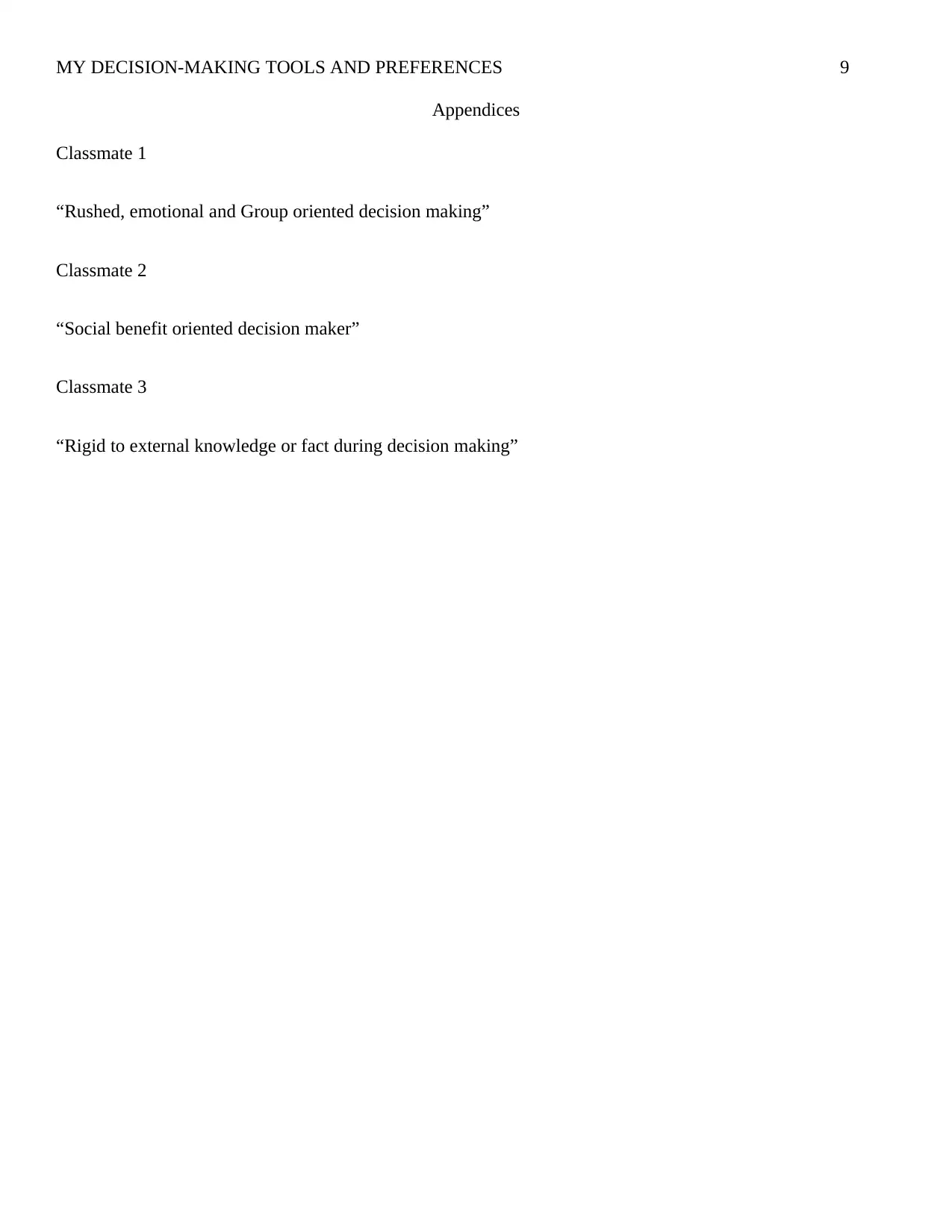
MY DECISION-MAKING TOOLS AND PREFERENCES 9
Appendices
Classmate 1
“Rushed, emotional and Group oriented decision making”
Classmate 2
“Social benefit oriented decision maker”
Classmate 3
“Rigid to external knowledge or fact during decision making”
Appendices
Classmate 1
“Rushed, emotional and Group oriented decision making”
Classmate 2
“Social benefit oriented decision maker”
Classmate 3
“Rigid to external knowledge or fact during decision making”
⊘ This is a preview!⊘
Do you want full access?
Subscribe today to unlock all pages.

Trusted by 1+ million students worldwide
1 out of 9
Related Documents
Your All-in-One AI-Powered Toolkit for Academic Success.
+13062052269
info@desklib.com
Available 24*7 on WhatsApp / Email
![[object Object]](/_next/static/media/star-bottom.7253800d.svg)
Unlock your academic potential
Copyright © 2020–2025 A2Z Services. All Rights Reserved. Developed and managed by ZUCOL.




